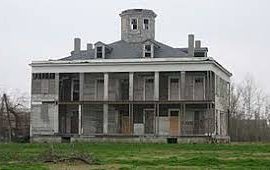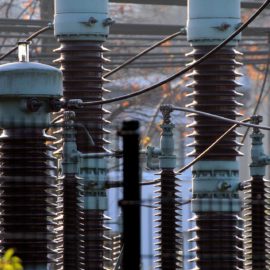
Grand Isle is Louisiana’s barrier island that is doing what barrier island do – changing shape.
The structure taking shape on Grand Isle’s western edge rises 20 feet in the air, not unlike most houses on the barrier island, where stilts are the best defense from the threatening Gulf of Mexico. Still, the massive concrete grid being erected and topped with a metal platform stands out. The site manager says people who pass it — there’s only one road in and out of town — constantly call City Hall asking what it is. It’s an Entergy Louisiana substation, the biggest such elevation project the utility has ever undertaken. It has plans for a similar project on the Bolivar Peninsula, a flood-prone area near Galveston, Texas. The raised substation is part of an array of projects Entergy has done in coastal Louisiana after Hurricane Ida ravaged its grid, demolishing the old, ground-level substation and snapping power poles that lined the highway into Grand Isle. Entergy has also completed its largest undergrounding project here, an 8-mile span along Louisiana 1 between Grand Isle and Leeville. And the utility rebuilt and strengthened the electric poles that snapped during Ida, using pieces of the Keystone XL pipeline as steel caissons to fortify the bases.
nola.com
The cost of these structures gets into the millions.
The pricey projects illustrate the extraordinary lengths it takes to make Grand Isle livable in the face of climate change. The Caminada substation, named after the nearby bay, is slated to cost $22 million and could wind up closer to $30 million, according to a site official. In all, Entergy said it is spending a total of $80 million on projects in Grand Isle. That shakes out to $80,000 per permanent resident, though the costs will be spread across all Entergy Louisiana ratepayers. The recent spending by Entergy is not the only costly effort underway that aims to protect the vulnerable barrier island. The U.S. Army Corps of Engineers is spending $122 million to repair Grand Isle’s “burrito levee,” which was torn apart by Ida, and bolster the island’s beach protections. Jefferson Parish leaders are looking for upwards of $30 million to bury a water line that travels 32 miles from Lafitte to Grand Isle to protect it from natural disasters. Taken together, the costs of all those efforts amount to about $232,000 per resident — raising thorny questions about the cost of making coastal areas livable, who should pay for it and how the state should go about deciding which projects to fund.
Cultural heritage or money dump. Both terms fit.
Local leaders say the island holds huge cultural importance to Louisiana and represents a crucial buffer for slowing down hurricanes and storm surge. Entergy officials add that the area is a key economic driver and attracts tourists from all over the region. “I don’t think the economic importance of south Lafourche, Grand Isle and Port Fourchon can be overstated,” said David Freese, an Entergy spokesperson. “This part of the world is really important to Louisiana’s economy. We went and did what we could to make the system more resilient so Louisiana and communities down here are more resilient as well.”
Grand Isle is a microcosm of the lower part of the state.
Grand Isle may be particularly vulnerable, but its challenges are not unique. South Louisiana is threatened by rising seas, coastal erosion and ever-more powerful storms. The state’s aging infrastructure — the electric grid, water systems and roads in low-lying areas, among others — have proven incapable of withstanding those threats. And while the state is in a relatively healthy financial position right now, there are far more improvements needed than money to pay for them. Jefferson Parish Council member Ricky Templet, who represents Grand Isle, said the state cannot afford to give up on places that serve as such a crucial line of defense for storms. He said the state needs to “keep the fight” in Grand Isle, and he heralded the Entergy projects as part of that fight. “We do live in America,” he said. “If they’re part of Jefferson Parish, they need the same services the rest of the parish and the rest of the country has.”
That may be so, but there are factors making it a difficult decision.
Alex Kolker, an associate professor at Louisiana Universities Marine Consortium, better known as LUMCON, said Grand Isle has two main things working against it: subsidence, which his research shows has actually slowed in recent years as drilling off the coast tapered off, and sea-level rise, which is accelerating. He pointed to the state’s coastal master plan to illustrate the risks. In 50 years, according to the latest draft, much of Grand Isle will see between 4 and 10 feet of water if a storm with a 1% chance of occurring in a given year hits. And that’s assuming the state follows through on its multi-billion dollar plan to build huge swaths of new land. Kolker said the master plan does a good job of selecting the “optimal projects” for rebuilding land. But it does not address key “human questions” that take into account, for instance, the cultural importance of a place like Grand Isle, and whether the government should step in to help relocate people. “That’s a much more human question: Should people stay? Should people go? Is it worth it? Is it not worth it?” Kolker said.
Grand Isle is still a disaster area.
On a recent Tuesday, many structures on Grand Isle still lay in ruin from damage caused by Ida, and scattered debris lined the street as rainfall accumulated. Crews couldn’t work on the Entergy substation that day because of high winds. The state park on the island’s eastern edge is still closed. A pier for hikers is now a wooden walkway that leads halfway to the beach before collapsing in a pile of rubble. Another pier further west is decimated, with a small section standing alone in the shallow Gulf waters, disconnected from the rest. About 40 trailers occupy a parking lot at the park, housing people who are still rebuilding. The stronger poles and elevated substation Entergy is installing at Grand Isle provide a window into a more sweeping resilience plan the utility has submitted to its regulator, the Louisiana Public Service Commission. The 10-year, $9.6 billion plan, slated to begin next year, would bring projects similar to the ones in Grand Isle to much of the state. To combat what officials called “poor soil conditions,” the company stuck massive steel caissons 20 feet in the ground to hold the electric poles in place. They buried a stretch of power lines 6 feet underground, but stopped short of burying all of them, partly because of the high cost. Erik Grille, Entergy’s manager of capital projects, said the substation is built to a “500-year flood” standard; the poles with steel caissons are built to withstand 150 mph winds. He’s hopeful the new equipment will last. “At our meetings we talk about how a 500-year flood event seems to come every year,” Grille said during a site visit to the project.
Ida did Grand Island no favor.
Ida knocked out power to Grand Isle for 138 days and flattened more than 700 structures in the town. The town ran on generator power until Entergy restored service through a temporary substation it built near the new one. Entergy called the damage on Grand Isle “catastrophic.” Freese, Entergy’s spokesperson, said the utility believes all ratepayers will benefit from the projects because rebuilding after future storms — customers pay for restoration costs — will be lower. Grand Isle Mayor David Camardelle, who has vocally supported the Entergy projects, didn’t respond to messages. But in a 2021 interview, he said, “as long as there’s a grain of sand to place the American flag on Grand Isle, we’re going to keep saving it.” Rob Verchick, an environmental law professor at Loyola whose forthcoming book, “The Octopus in the Parking Garage,” explores climate resilience in coastal regions, said the PSC needs to be more proactive when evaluating how utilities are planning for the future. For years, the commission has largely reacted to plans made by Entergy. Verchick said the state should look to New York, whose utility regulator demanded that ConEdison create a resilience plan based on climate projections that modeled sea rise, temperature increases and rainfall accumulation over several decades.
How does saving Grand Isle fit into the other needed projects to help the coast?
More broadly, Verchick said the state needs to make hard decisions about where to spend limited dollars on climate adaptation. Coastal areas around the country will all be seeking government aid, he said, and there won’t be enough to go around. He suspects that it is possible to invest enough money into coastal areas like Grand Isle to make them habitable in the future. But it’s a question of how to best allocate a limited amount of resources. “What we don’t acknowledge is we are going to be having migrations and relocations,” he said. “The only question is are they going to be planned and organized, or are they going to be haphazard and inefficient and chaotic and unfair to the people involved? “We have a lot of choices we can make on how we spend our money, how we preserve our values and how we live in particular places.”
First, stop waving America when it is a local problem. Second, how much do I have to pay so you can live on the water?



